
Are you interested in re-growing your very own vegetables from your kitchen scraps?
If so, you’ll really enjoy recycling and replanting your kitchen scraps once you start seeing what your vegetable trimmings can do.
Believe it or not, with some natural light and a little bit of water and soil, some of the best vegetables and herbs from the grocery store can be regrown in your kitchen!
That’s all you’ll really need, actually.
You can re-grow fresh greens indoors on a window sill, or re-grow your food scraps on your kitchen counter, either way, your indoor garden can start with a fun herb selection or eventually turn into a full-blown vegetable garden, the choice is yours!
Here are some of the best and easier vegetable trimmings to regrow from the scraps of food (you would just throw away anyway), to help you master your very own indoor kitchen garden!
Similar topics:
- 10+ Pantry & Food Items to Stock Up on in Case of an Emergency
- 10 Things in the Kitchen That Are Making You Sick
- 11 Clever Ways to Save Money on Groceries
When is the best time of year to regrow kitchen scraps?
Before you begin re-growing your new food from your old kitchen scraps, you’ll especially want to do this in the winter months and early spring.
Doing so will not only be particularly exciting to breathe fresh life into your kitchen from the moment it was just a measly food scrap but regrowing food is a great indoor hobby to do in the colder months, especially when your outside garden is hibernating in the cold.
Why would anyone want to regrow kitchen scraps?
Another reason why you will want to regrow these vegetables and herbs in your kitchen is you can save money from vegetable trimmings that you’d already throw out anyway.
Plus, it’ll be extra tasty and rewarding because you made it all on your own.
Now, take a look at some handy supplies that you may need first before you start embarking on re-growing food from your old kitchen scraps!
What vegetables regrow from cuttings?
When it comes to regrowing your vegetables at home, these are the most popular ones to regrow:
- Lettuce.
- Celery.
- Green onions.
- Ginger.
- Garlic.
- Fennel.
- Basil.
All of these vegetables have instructions below, and I have also incorporated a few other unique veggies that you can easily regrow from kitchen scraps so you can have a few different creative ways to regrow lots of vegetables in your home.
Helpful Supplies You May Need to regrow kitchen scraps:
- Pots — You can recycle and upcycle any type of container you have on hand!
- Newspapers — great for covering soil to create extra moisture
- Sharp kitchen knife
- Starting pots
- Organic compost
- Organic fertilizer
Now that you have a good general idea on when to grow your new food from your old rotting vegetables, here are 10+ easy veggies and herbs to regrow from kitchen scraps!
10 Best Veggies to Regrow from Kitchen Scraps
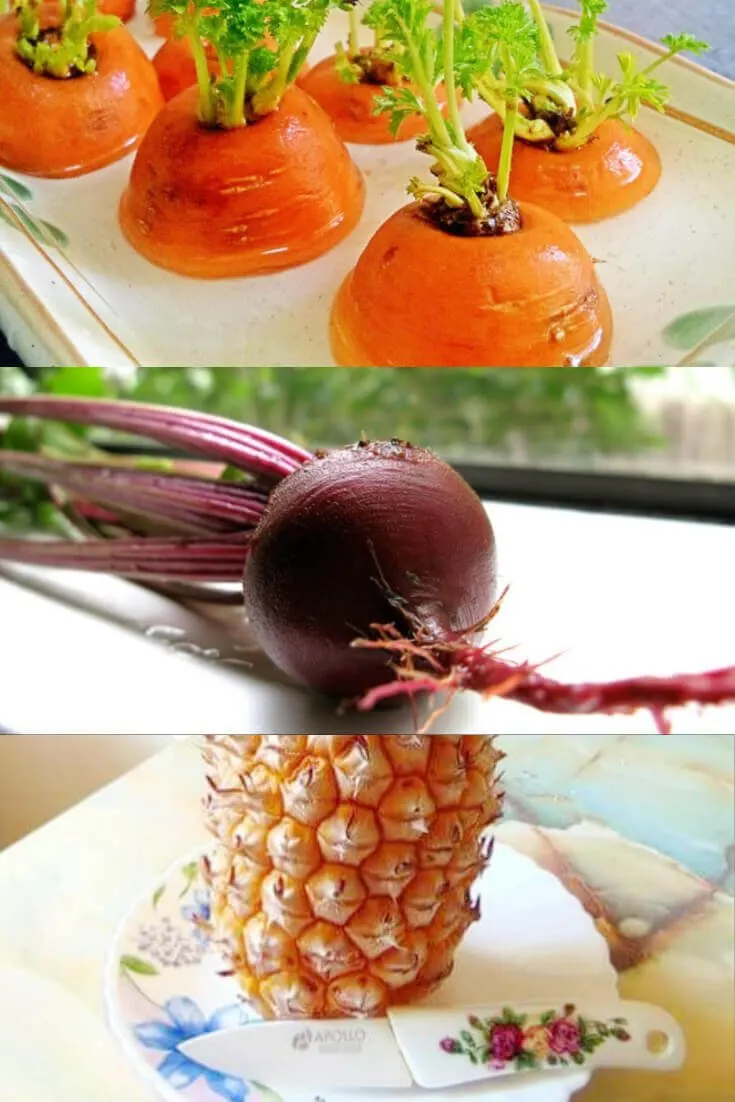
1. Grow a Pineapple plant and have it bear fruit from Scraps.
You can easily grow a beautiful pineapple plant from the leafy top of pineapple — the part you would usually discard or compost — that can flower and bear fruit if done right.
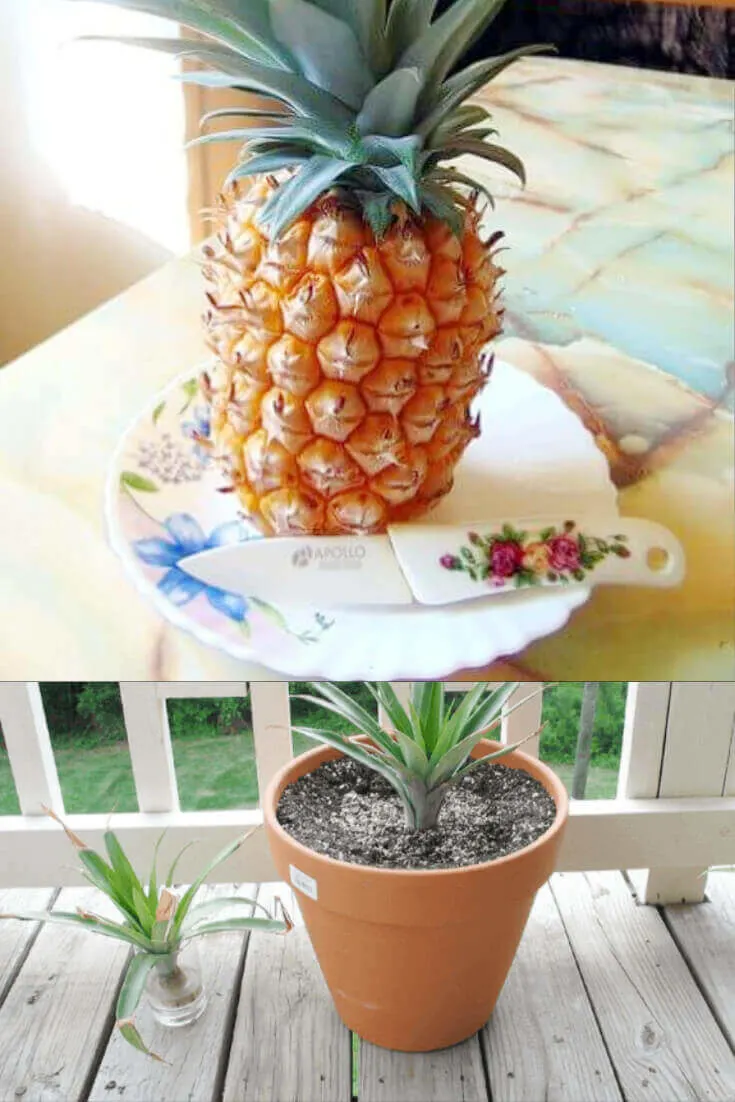
All you need is a jar, some soil, and a pot, and with a little bit of time, you will have your very own homemade pineapple plant (image source flickr).
How to regrow pineapple from scraps:
- At the grocery store, pick a healthy pineapple that has beautiful, good healthy-looking leaves.
- Cut the top part of the leaves cluster off about 1/2 inch below the base.
- Cut the rest of the pineapple as you would usually, and munch while you prepare the top for planting.
- Place the crown of the pineapple by a sunny window to dry out for 3-5 days. Doing this will help and enable the removal of any moisture in its core. It also discourages it from rotting if placed in the sun.
- Next, locate a decent size glass jar and place the pineapple crown in an inch of water in the jar.
- Insert toothpicks around the crown’s edge and hang it in the water just as you would an avocado pit. Put another way, most of the crown should only be positioned “hovering” over the water with the bottom of the pineapple being only immersed 1 inch of water.
Don’t forget to place the jar in direct sunlight in a bright sunny place in your home, and rotate out the old water with clean water once per week until you see the roots emerging. Typically, you should see some roots appear in the water bath after 2-3 weeks.
When the roots are 2-3 inches long, the pineapple crown can then be safely removed from the water bath and replanted in light soil in a plant pot of your choice.
Make sure it’s getting at least six hours of bright daylight a day— giving your new pineapple plant a suitable home to bear fruit in the future!
2. How to regrow Beet Greens with No Green Thumb Needed.
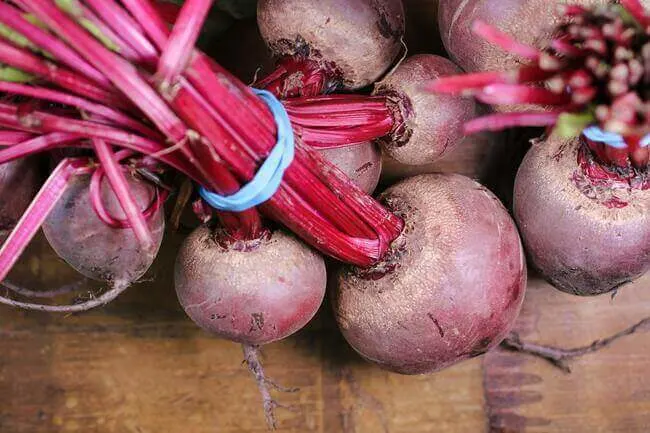
Beets are a beauty to regrow. All you have to do is buy a bunch of beets that still have the tops attached. Trim off the greens and use them to cook! (Those leaves are tasty!).
How to regrow beet greens:
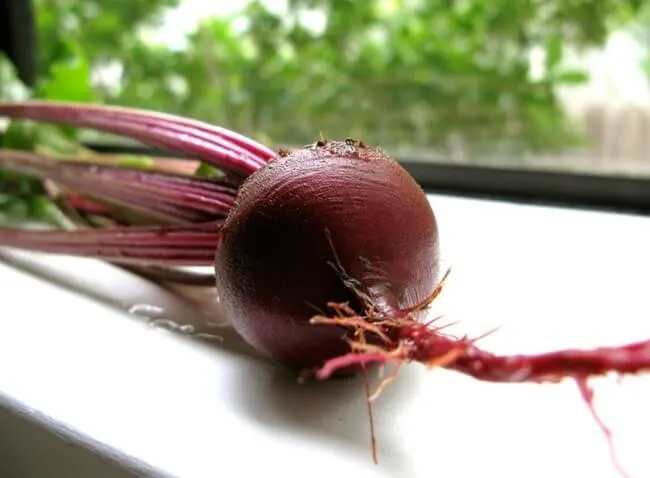
- Cut off the top of the beets, leaving at least 1/2 inch of beetroot.
- Then place them cut-side down in a water dish.
- Leave resting in a sunny spot in your kitchen to let them regrow ( image source via Flickr)
You should expect to see beet greens in a matter of a week. Just trim what you need and cook away.
3. How to regrow Green Onions in a jar.
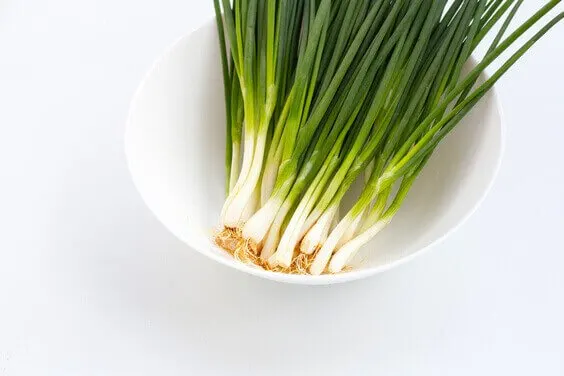
Green onions are probably the most common and easiest vegetable to re-grow.
How to regrow green onions:
- All you need to do is cut the green onions from the roots by about an inch and leave them in a glass of water.
- Place by a sunny window and trim as they grow. Easy peasy!
4. How to Grow New Potatoes From Peelings.
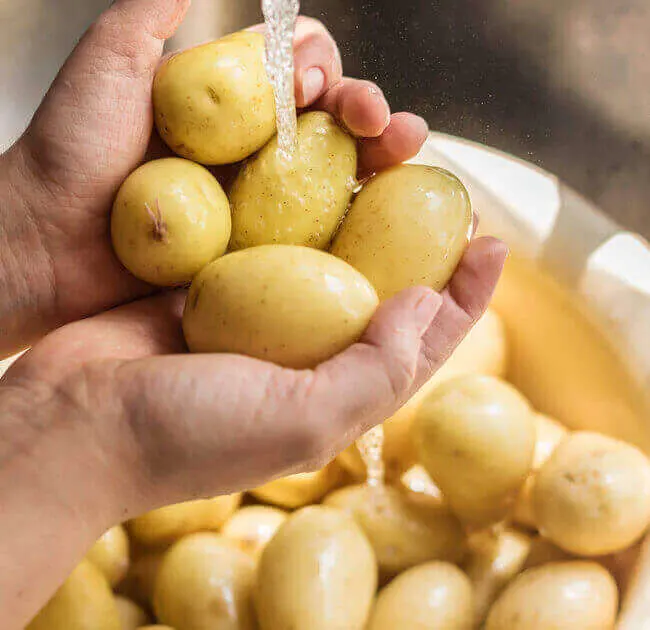
The eyes have it when it comes to re-growing potatoes: that is to say, potato eyes. Each of the little dormant buds on the skin of potatoes is a possible sprout so this is what you have to keep in mind when you are cutting or peeling.
How to regrow new potatoes from peelings:
- When you are peeling your potatoes, make sure that the pieces from scraps have at least one to two eyes.
- Let the pieces stay and dry overnight or for a few days at room temperature to help them retain their moisture on the inside and that they get dry to the touch.
- Once the potato halves or peels are dry, replant them in 8 inches of soil, about one foot apart (for outside) or in a large enough pot with 8 inches width and depth for indoors.
Potatoes don’t need too much direct sunlight, so anywhere in your home that gets natural light should be fine. You can replant them from the pot to outdoors, or enjoy a new potato indoors after just 10 weeks.
5. How to regrow Spring Onions in soil.
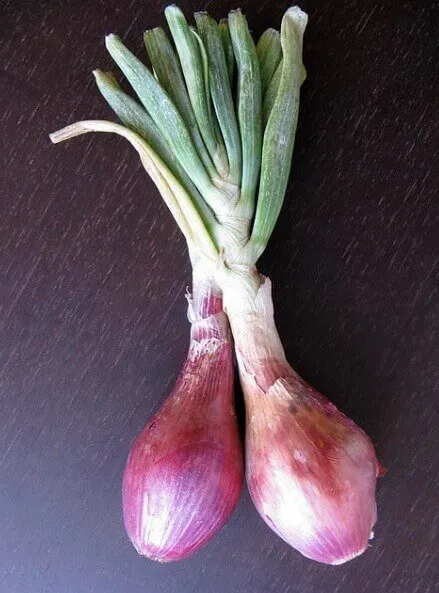
Spring onions may also be regenerated from a regular onion bulb. (image source Steven Damron)
How to regrow spring onions:
- Make sure there is about half an inch of growth attached to the root bulb portion before you cut.
- Drop that cut portion into a pot with soil directly and cover it with a layer of moist soil.
- Try to keep the soil moist, regularly while it’s growing by a sunny window.
How to care for spring onions while they grow:
- The best way to care for a spring onion is by giving it lots of water, so be sure that the soil always remains moist. It’s also important not to disturb them during their growing period; this should last from six weeks up until they’ve established themselves in the soil.
- You can chop off the green sprouts to eat when they appear until they have regrown again.
6. How to regrow Carrot Greens for salads from scraps.
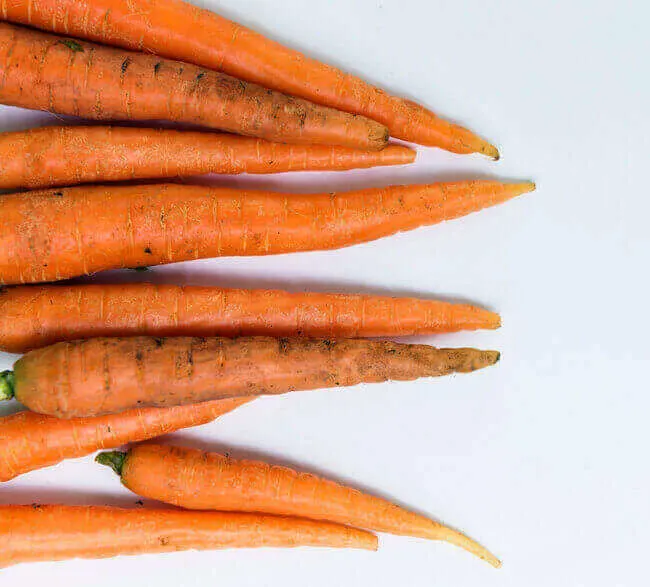
If you want to reuse your carrots, carrot greens are really tasty in a salad.
How to regrow carrot greens:
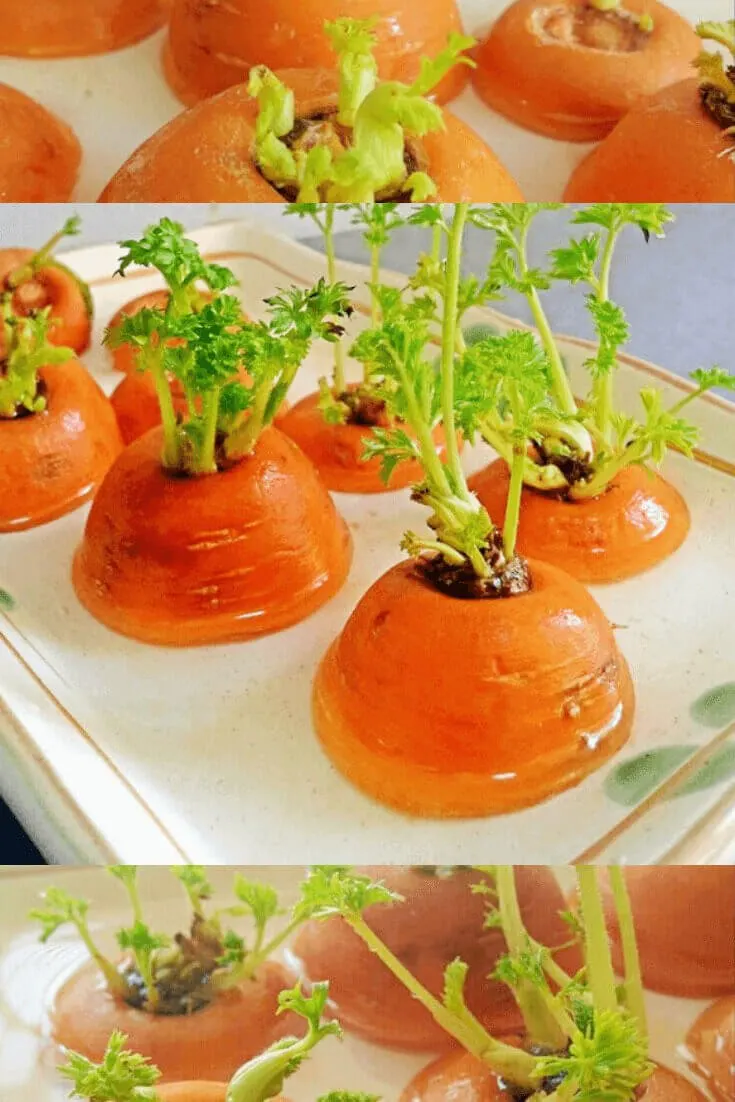
- First, place the carrot tops (heads) down onto a tray or plate.
- Add water to the plate so that 1/4 “of water flows past the surface of the carrot head.
- Place beside a sunny windowsill making sure that the scraps are receiving a fair amount of sunlight.
- Keep rinsing out the water until you see new growth.
Once greens from the carrots have been regrown, transfer them to an indoor container with soil and water them when the soil gets dry. Trim, cook, and eat! (image source Instructables)
7. How to regrow Celery on the kitchen window sill.
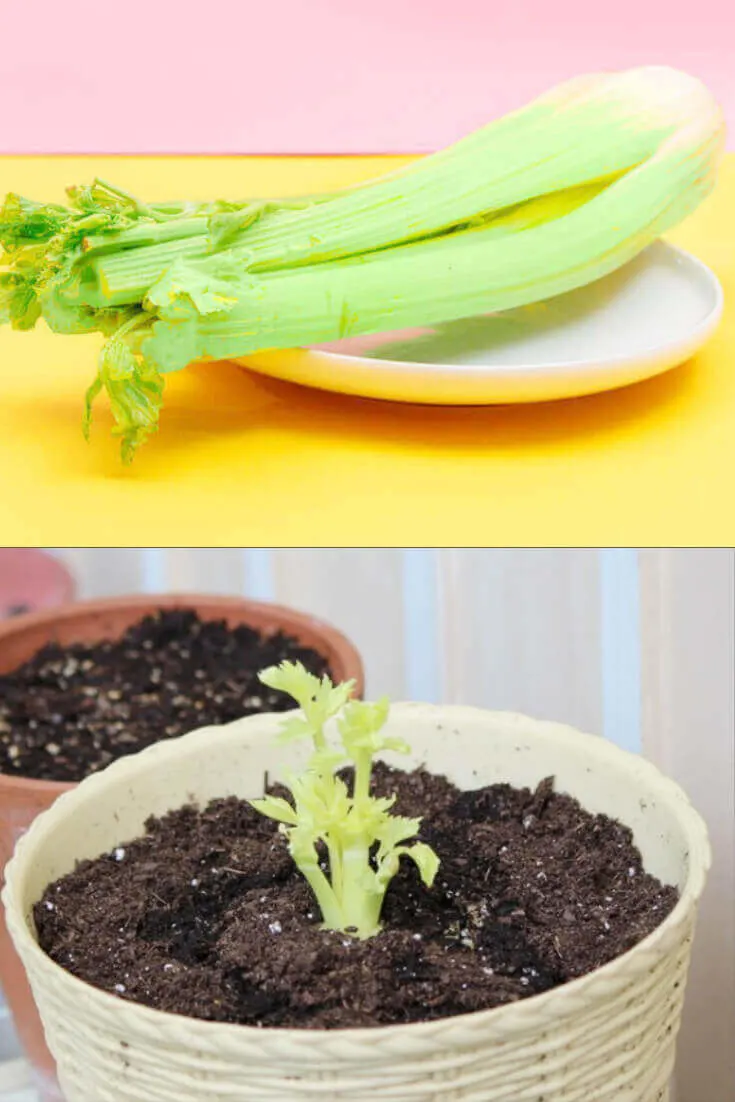
One of the easier vegetable scraps to regrow is celery. You just have to make sure you grow the right one! Since you will be regrowing the celery from the grocery store, you’ll most likely be using the pascal celery variety. ( image source Maggiesdaisy)
Pascal celery is the “green titan” of celery. It’s a classic favorite that produces large, crisp, flavorful stalks. This is a long-lasting variety that is productive and easy to grow.
How to regrow celery:
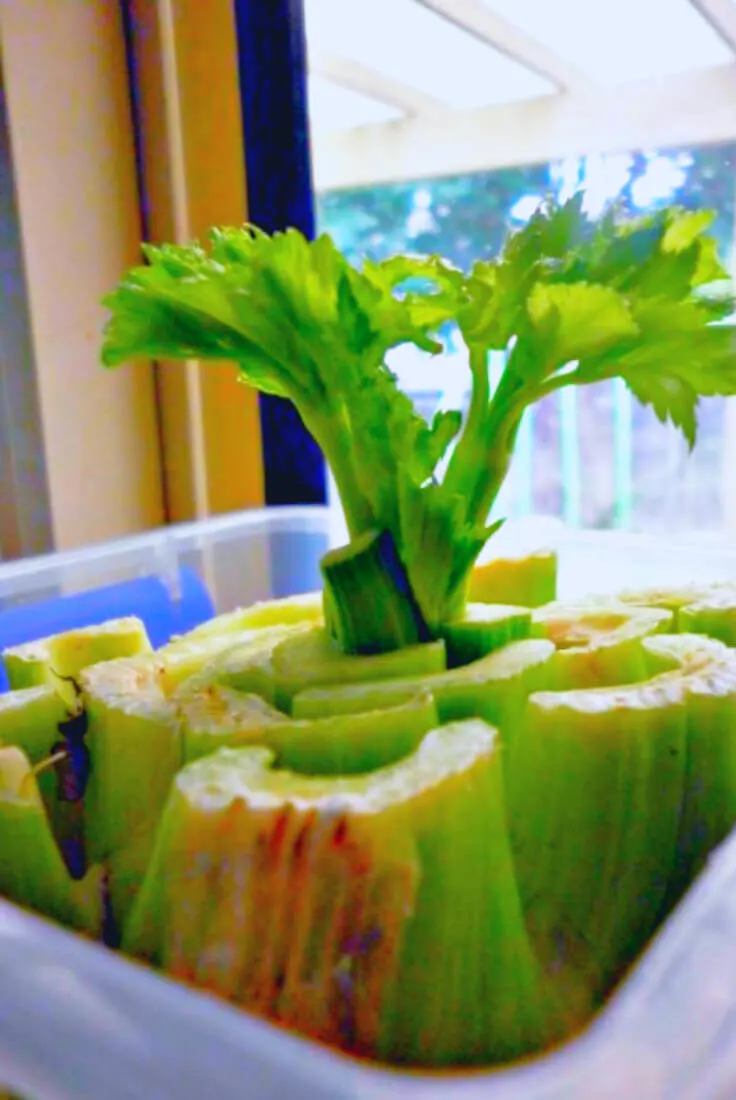
- Cut the celery off by the base of the roots, and leave the base for about an inch or two of room.
- Place the base in a bowl of water, with the stalks facing upwards.
- Leave it where sufficient sunlight can be obtained and rinse out the water every week.
- As new leaves start to sprout from the center, allow it to gain thickness for about a week or so before being moved into a pot of soil. (image source Saunderses)
8. How to regrow Romaine Lettuce, Bok Choy, and Cabbage.
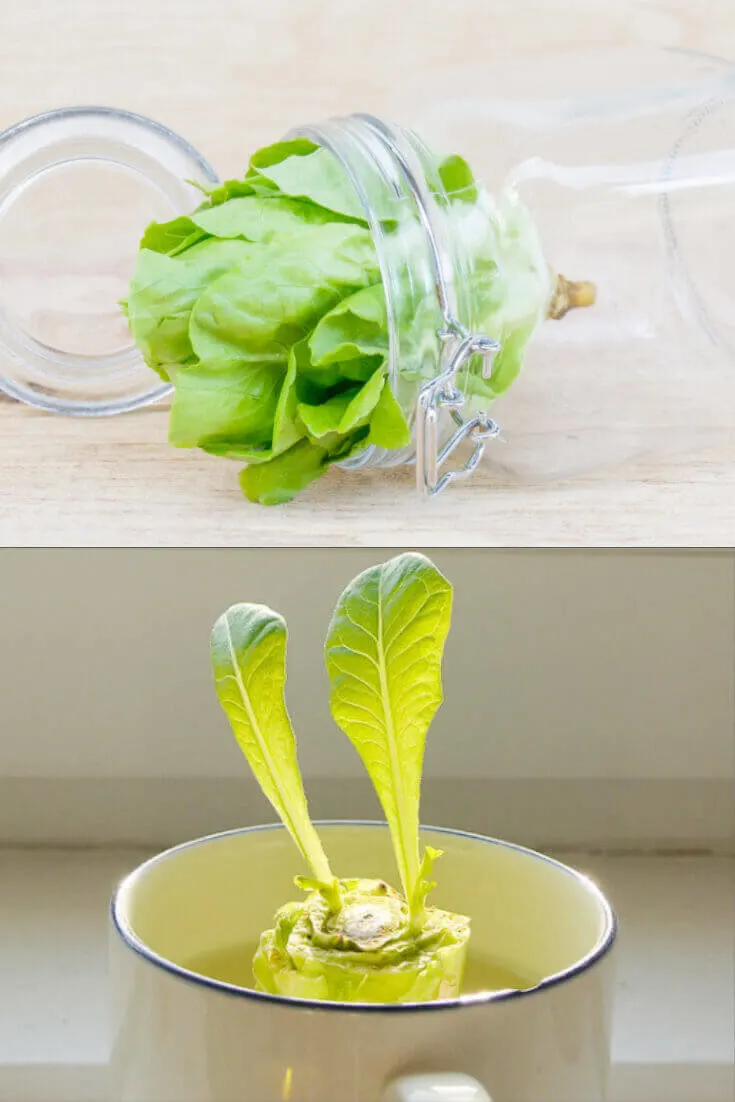
Romaine lettuce, cabbage, and bok choy are as simple as celery to regrow in your kitchen. Here’s how to do it! (image source .Ines)
How to regrow lettuce, cabbage, and bok choy:
- Leave the stub of whatever vegetable you choose to regrow in a bowl and fill the water halfway through, covering the base of the roots.
- Let the growing happen with natural sunlight.
- Placed by a sunny window the leaves will regrow in just a matter of days. Once that happens, you can safely move your stumps to a soil pot and enjoy seeing it regrow from there.
There you have it. If you decide to regrow your old food scraps into edible food, you’ll realize how much fun it is to recreate food from what was once just measly old ‘food waste’. You’ll also really love free plants!
I hope you enjoyed this article, please share it with anyone who you think would love to grow one of these veggies at home!
More home lifestyle ideas:
- 10+ Pantry & Food Items to Stock Up on in Case of an Emergency
- 10 Things in the Kitchen That Are Making You Sick
- 11 Clever Ways to Save Money on Groceries
- 10 Meal Prep Tips That’ll Make Your Week So Much Easier
- 6 Solid Good Reasons to Shop with a Grocery List
Author: Everything Abode
Welcome to Everything Abode, your daily inspiration for every activity at home!
Our goal is to inspire you to live an elegant and chic lifestyle from the comfort of your home.
We’ll help you express yourself through authentic style, aesthetic beauty, and stylish home decor.
Subscribe to Get the Tools That Make My Blog Successful!

When you join my newsletter, I'm going to send you insider advice and tools that I use to grow my blog! I only save the BEST for my email list so don't wait!

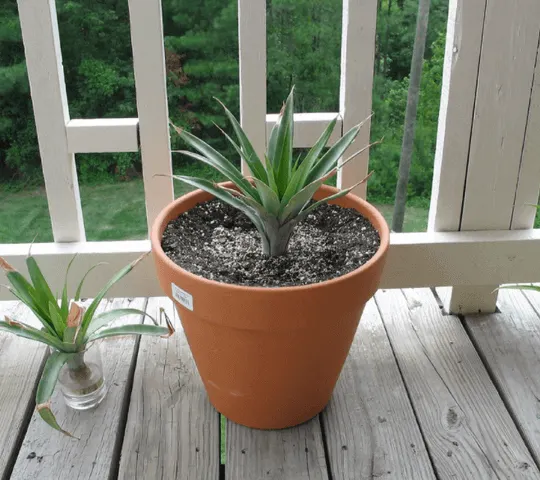
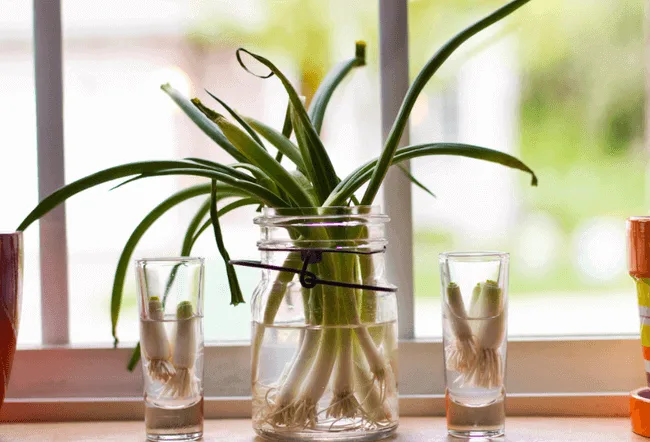
60+ Indoor Hobbies You Should Try at Home - Everything Abode
Wednesday 25th of August 2021
[…] creating an indoor herb garden as an excellent indoor hobby for your green thumb all year […]